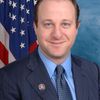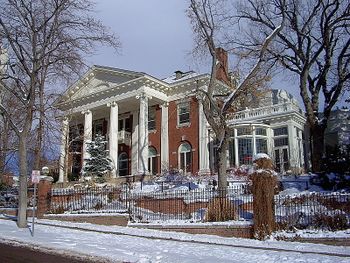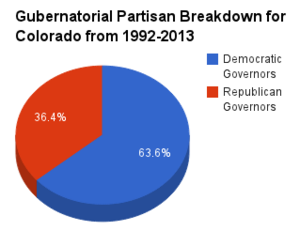Governor of Colorado
 From Ballotpedia - Reading time: 24 min
From Ballotpedia - Reading time: 24 min
| Colorado Governor | |
 | |
| General information | |
| Office Type: | Partisan |
| Office website: | Official Link |
| Compensation: | $90,000 |
| 2024 FY Budget: | $63,769,189 |
| Term limits: | Two consecutive terms |
| Structure | |
| Length of term: | 4 years |
| Authority: | Colorado Constitution, Article IV, Section 2 |
| Selection Method: | Elected |
| Current Officeholder | |
Governor of Colorado
Jared Polis | |
| Elections | |
| Next election: | November 3, 2026 |
| Last election: | November 8, 2022 |
| Other Colorado Executive Offices | |
| Governor • Lieutenant Governor • Secretary of State • Attorney General • Treasurer • Controller • Commissioner of Education • Agriculture Commissioner • Insurance Commissioner • Natural Resources Exec. Director • Labor Executive Director • Public Utilities Commission • Colorado State Board of Regents | |
The Governor of Colorado is an elected constitutional officer, the head of the executive branch and the highest state office in Colorado. The governor is popularly elected every four years by a plurality and is limited to two consecutive terms.
Until 1967, the governor and the lieutenant governor were elected on separate tickets for two-year terms. Term length for both offices was increased to four years in 1967, and in 1986 the constitution was amended to elect both on the same ticket. The two-term limit was added to the constitution in 1991.[1]
Colorado has a Democratic trifecta. The Democratic Party controls the office of governor and both chambers of the state legislature.
Colorado has a Democratic triplex. The Democratic Party controls the offices of governor, secretary of state, and attorney general.
Current officeholder[edit]
- See also: Current governors by party affiliation
The 43rd and current governor is Jared Polis (D). He was first elected in 2018. Polis took office on January 9, 2019.
Before becoming governor, Polis represented Colorado's 2nd Congressional District in the U.S. House of Representatives from 2009 to 2019.[2]
Authority[edit]
The state constitution establishes the office of the governor in Article IV, the Executive Department.
Colorado Constitution, Article IV, Section 2
|
The supreme executive power of the state shall be vested in the governor, who shall take care that the laws be faithfully executed.[1] |
Colorado Constitution, Article II, Section 2
|
All political power is vested in and derived from the people; all government, of right, originates from the people, is founded upon their will only, and is instituted solely for the good of the whole.[1] |
Qualifications[edit]
| State Executives |
|---|
| Current Governors |
| Gubernatorial Elections |
| 2024 • 2023 • 2022 • 2021 • 2020 • 2019 • 2018 • 2017 • 2016 • 2015 • 2014 |
| Current Lt. Governors |
| Lt. Governor Elections |
| 2024 • 2023 • 2022 • 2021 • 2020 • 2019 • 2018 • 2017 • 2016 • 2015 • 2014 |
Article IV, Section 4 of the state constitution requires all candidates for the governorship to be:
- at least 30 years old
- a U.S. citizen
- a resident of Colorado for at least two years on the day of the election. The standard for residency is not affected by time out of the state due to civil or military service (Article VII, Section 4)
Article III forbids any officer of the executive department from holding any legislative or judicial office.
A candidate is disqualified from holding the office of governor if he or she has been convicted of "embezzlement of public moneys, bribery, perjury, solicitation of bribery, or subornation of perjury"(Article XII, § 4). Additionally, any civil officer who "solicits, demands, or receives" a bribe forfeits his or her office and his or her right to hold any other office in the future, and is liable to criminal penalties (Article XII, § 6).[1]
Colorado Constitution, Article IV, Section 4
|
No person shall be eligible to the office of governor or lieutenant governor unless he shall have attained the age of thirty years, nor to the office of secretary of state or state treasurer unless he shall have attained the age of twentyfive years, nor to the office of attorney general unless he shall have attained the age of twentyfive years and be a licensed attorney of the supreme court of the state in good standing, and no person shall be eligible to any one of said offices unless, in addition to the qualifications above prescribed therefore, he shall be a citizen of the United States, and have resided within the limits of the state two years next preceding his election. |
Elections[edit]
- See also: Gubernatorial election cycles by state
- See also: Election of governors
Colorado elects governors in federal midterm election years (e.g. 2018, 2022, 2026, 2030). Per Article IV, Section 1 of the state constitution, the gubernatorial inauguration is always set for the second Tuesday in the January following an election.
If two candidates are tied, a joint session of the legislature casts ballots to choose the winner from among the top two voter getters. If the election is contested, the legislature shall jointly resolve the manner as prescribed by law. In early 1905, the previous year's gubernatorial election was formally contested and the legislature did in fact vote to remove the candidate who had been initially declared the winner.
Colorado Constitution, Article IV, Section 1
|
(1) The executive department shall include the governor, lieutenant governor, secretary of state, state treasurer, and attorney general, each of whom shall hold his office for the term of four years, commencing on the second Tuesday of January in the year 1967, and each fourth year thereafter. They shall perform such duties as are prescribed by this constitution or by law. |
2022[edit]
General election
General election for Governor of Colorado
The following candidates ran in the general election for Governor of Colorado on November 8, 2022.
Candidate | % | Votes | ||
| ✔ |  | Jared Polis (D) | 58.5 | 1,468,481 |
 | Heidi Ganahl (R)  | 39.2 | 983,040 | |
 | Kevin Ruskusky (L)  | 1.2 | 28,939 | |
 | Danielle Neuschwanger (American Constitution Party)  | 0.9 | 21,623 | |
 | Paul Fiorino (Unity Party) | 0.3 | 6,687 | |
 | Zachary Varon (Independent) (Write-in) | 0.0 | 52 | |
 | Paul Willmon (Independent) (Write-in) | 0.0 | 8 | |
| Total votes: 2,508,830 | ||||
 = candidate completed the Ballotpedia Candidate Connection survey. = candidate completed the Ballotpedia Candidate Connection survey. | ||||
| If you are a candidate and would like to tell readers and voters more about why they should vote for you, complete the Ballotpedia Candidate Connection Survey. | ||||
Do you want a spreadsheet of this type of data? Contact our sales team. | ||||
Withdrawn or disqualified candidates
- Bill Stevens (Approval Voting Party)
- Ralph Tingle (Independent)
- Laurie Clark (R)
Democratic primary election
Democratic primary for Governor of Colorado
Incumbent Jared Polis advanced from the Democratic primary for Governor of Colorado on June 28, 2022.
Candidate | % | Votes | ||
| ✔ |  | Jared Polis | 100.0 | 523,481 |
| Total votes: 523,481 | ||||
 = candidate completed the Ballotpedia Candidate Connection survey. = candidate completed the Ballotpedia Candidate Connection survey. | ||||
| If you are a candidate and would like to tell readers and voters more about why they should vote for you, complete the Ballotpedia Candidate Connection Survey. | ||||
Do you want a spreadsheet of this type of data? Contact our sales team. | ||||
Withdrawn or disqualified candidates
- Dustin Rorex (D)
Republican primary election
Republican primary for Governor of Colorado
Heidi Ganahl defeated Greg Lopez in the Republican primary for Governor of Colorado on June 28, 2022.
Candidate | % | Votes | ||
| ✔ |  | Heidi Ganahl  | 53.9 | 341,145 |
 | Greg Lopez | 46.1 | 292,171 | |
| Total votes: 633,316 | ||||
 = candidate completed the Ballotpedia Candidate Connection survey. = candidate completed the Ballotpedia Candidate Connection survey. | ||||
| If you are a candidate and would like to tell readers and voters more about why they should vote for you, complete the Ballotpedia Candidate Connection Survey. | ||||
Do you want a spreadsheet of this type of data? Contact our sales team. | ||||
Withdrawn or disqualified candidates
- Jim Rundberg (R)
- Benjamin Huseman (R)
- Jon Gray-Ginsberg (R)
- Jeffrey Fry (R)
- Destinee Workman (R)
- Laurie Clark (R)
- Darryl Gibbs (R)
- Jason Wilkat (R)
- Zachariah Burck (R)
- Jason Lopez (R)
- Danielle Neuschwanger (R)
Approval Voting Party convention
Approval Voting Party convention for Governor of Colorado
Bill Stevens advanced from the Approval Voting Party convention for Governor of Colorado on March 26, 2022.
Candidate | ||
| ✔ |  | Bill Stevens (Approval Voting Party) |
 = candidate completed the Ballotpedia Candidate Connection survey. = candidate completed the Ballotpedia Candidate Connection survey. | ||||
| If you are a candidate and would like to tell readers and voters more about why they should vote for you, complete the Ballotpedia Candidate Connection Survey. | ||||
Do you want a spreadsheet of this type of data? Contact our sales team. | ||||
2018[edit]
General election
General election for Governor of Colorado
Jared Polis defeated Walker Stapleton, Scott Helker, and Bill Hammons in the general election for Governor of Colorado on November 6, 2018.
Candidate | % | Votes | ||
| ✔ |  | Jared Polis (D) | 53.4 | 1,348,888 |
 | Walker Stapleton (R) | 42.8 | 1,080,801 | |
 | Scott Helker (L) | 2.8 | 69,519 | |
 | Bill Hammons (Unity Party) | 1.0 | 25,854 | |
| Total votes: 2,525,062 | ||||
 = candidate completed the Ballotpedia Candidate Connection survey. = candidate completed the Ballotpedia Candidate Connection survey. | ||||
| If you are a candidate and would like to tell readers and voters more about why they should vote for you, complete the Ballotpedia Candidate Connection Survey. | ||||
Do you want a spreadsheet of this type of data? Contact our sales team. | ||||
Withdrawn or disqualified candidates
- Korey Paul Starkey (Independent)
- Veronique Bellamy (G)
- George Allen Cantrell (Constitution Party)
- Michael Wilbourn (Independent)
- Kathleen Cunningham (Unaffiliated)
- Paul Willmon (Unaffiliated)
- Richard Osada (Independent)
- Matthew Wood (Independent)
Democratic primary election
Democratic primary for Governor of Colorado
Jared Polis defeated Cary Kennedy, Michael Johnston, and Donna Lynne in the Democratic primary for Governor of Colorado on June 26, 2018.
Candidate | % | Votes | ||
| ✔ |  | Jared Polis | 44.5 | 283,340 |
 | Cary Kennedy | 24.7 | 157,396 | |
 | Michael Johnston | 23.5 | 149,884 | |
 | Donna Lynne | 7.3 | 46,382 | |
| Total votes: 637,002 | ||||
 = candidate completed the Ballotpedia Candidate Connection survey. = candidate completed the Ballotpedia Candidate Connection survey. | ||||
| If you are a candidate and would like to tell readers and voters more about why they should vote for you, complete the Ballotpedia Candidate Connection Survey. | ||||
Do you want a spreadsheet of this type of data? Contact our sales team. | ||||
Withdrawn or disqualified candidates
- Noel Ginsburg (D)
Republican primary election
Republican primary for Governor of Colorado
Walker Stapleton defeated Victor Mitchell, Greg Lopez, and Doug Robinson in the Republican primary for Governor of Colorado on June 26, 2018.
Candidate | % | Votes | ||
| ✔ |  | Walker Stapleton | 47.7 | 239,861 |
 | Victor Mitchell | 30.1 | 151,585 | |
 | Greg Lopez | 13.2 | 66,432 | |
 | Doug Robinson | 9.0 | 45,327 | |
| Total votes: 503,205 | ||||
 = candidate completed the Ballotpedia Candidate Connection survey. = candidate completed the Ballotpedia Candidate Connection survey. | ||||
| If you are a candidate and would like to tell readers and voters more about why they should vote for you, complete the Ballotpedia Candidate Connection Survey. | ||||
Do you want a spreadsheet of this type of data? Contact our sales team. | ||||
Withdrawn or disqualified candidates
- Barry Farah (R)
2014[edit]
- See also: Colorado gubernatorial election, 2014
Incumbent Gov. John Hickenlooper (D) faced three candidates in his re-election bid in 2014. Hickenlooper was challenged by Republican Bob Beauprez, Libertarian Party candidate Matthew Hess and Green Party candidate Harry Hempy. The general election took place on November 4, 2014.
| Governor and Lieutenant Governor of Colorado, 2014 | ||||
|---|---|---|---|---|
| Party | Candidate | Vote % | Votes | |
| Democratic | 49.3% | 1,006,433 | ||
| Republican | Bob Beauprez/Jill Rapella | 46% | 938,195 | |
| Libertarian | Matthew Hess/Brandon Young | 1.9% | 39,590 | |
| Green | Harry Hempy/Scott Olson | 1.3% | 27,391 | |
| Unaffiliated | Mike Dunafon/Robin Roberts | 1.2% | 24,042 | |
| Unaffiliated | Paul Fiorino/Charles Whitley | 0.3% | 5,923 | |
| Total Votes | 2,041,574 | |||
| Election results via Colorado Secretary of State | ||||
2010[edit]
- See also: Colorado gubernatorial election, 2010
On November 2, 2010, John Hickenlooper won election to the office of Governor of Colorado. He defeated Tom Tancredo (ACP), Dan Maes (R), Jaimes Brown (L), Jason Clark (I) and Paul Fiorino (I) in the general election.
| Governor of Colorado, 2010 | ||||
|---|---|---|---|---|
| Party | Candidate | Vote % | Votes | |
| Democratic | 51% | 912,005 | ||
| American Constitution Party | Tom Tancredo | 36.5% | 651,232 | |
| Republican | Dan Maes | 11.1% | 199,034 | |
| Libertarian | Jaimes Brown | 0.7% | 12,314 | |
| Independent | Jason Clark | 0.5% | 8,576 | |
| Independent | Paul Fiorino | 0.2% | 3,483 | |
| Total Votes | 1,786,644 | |||
| Election results via The New York Times. | ||||
Full history[edit]
To view the electoral history dating back to 1998 for the office of Governor of Colorado, click [show] to expand the section. | |||||||||||||||||||||||||||||||||||||||||||||||||||||||||||||||||||||||||||||||||||||||||||||||||||||||||||||||||||||||||||||||||||
|---|---|---|---|---|---|---|---|---|---|---|---|---|---|---|---|---|---|---|---|---|---|---|---|---|---|---|---|---|---|---|---|---|---|---|---|---|---|---|---|---|---|---|---|---|---|---|---|---|---|---|---|---|---|---|---|---|---|---|---|---|---|---|---|---|---|---|---|---|---|---|---|---|---|---|---|---|---|---|---|---|---|---|---|---|---|---|---|---|---|---|---|---|---|---|---|---|---|---|---|---|---|---|---|---|---|---|---|---|---|---|---|---|---|---|---|---|---|---|---|---|---|---|---|---|---|---|---|---|---|---|---|
|
2006 On November 7, 2006, Bill Ritter won election to the office of Governor of Colorado. He defeated Bob Beauprez (R), Dawn Winkler (L), Paul Fiorino (I), Clyde Harkins (C) and Charles "Chuck" Sylvester (Write-in) in the general election.
2002 On November 5, 2002, Bill Owens won re-election to the office of Governor of Colorado. He defeated Rollie Heath (D), Ronald Forthofer (G) and Ralph Shnelvar (L) in the general election.
1998 On November 3, 1998, Bill Owens won election to the office of Governor of Colorado. He defeated Gail Schoettler (D), Sandra D. Johnson (L) and Tim Leonard (C) in the general election.
| |||||||||||||||||||||||||||||||||||||||||||||||||||||||||||||||||||||||||||||||||||||||||||||||||||||||||||||||||||||||||||||||||||
Term limits[edit]
- See also: States with gubernatorial term limits
Colorado governors are restricted to two consecutive terms in office, after which they must wait one term before being eligible to run again. Term limits were added to the constitution in 1990 through the Colorado Term Limits Act.
Colorado Constitution, Article IV, Section 1
| (2) In order to broaden the opportunities for public service and to guard against excessive concentrations of power, no governor ... shall serve more than two consecutive terms in such office. This limitation on the number of terms shall apply to terms of office beginning on or after January 1, 1991. Any person who succeeds to the office of governor or is appointed or elected to fill a vacancy in one of the other offices named in this section, and who serves at least one-half of a term of office, shall be considered to have served a term in that office for purposes of this subsection (2). Terms are considered consecutive unless they are at least four years apart.[1] |
Removal from office[edit]
Colorado is among the 19 states that provides citizens an avenue to recall their governor. One territorial governor, Edward M. McCook, was removed by petition. No governors have been recalled since Colorado became a state in 1876. Additionally, the legislature may impeach the governor, a privilege they have never exercised.
Recall[edit]
Recalls are governed under Article XXI, Sections 1 through 3
State officials, including the governor, are subject to recall after the first six months of their term. Recall proponents must file a petition with the same officer who accepts the nominating petition for the office in question; for statewide officers, this is the Colorado Secretary of State.
The petition must have valid signatures equal to 25 percent of the votes cast for the incumbent in his last election. Based on the number of votes received by the governor in the 2014 election, a recall petition would require 510,393 signatures, or 25 percent of the 2,041,574 votes cast for John Hickenlooper. Additionally, the petition must contain a statement, not exceeding 200 words, stating the grounds for the recall.
Normally, the governor is the officer charged with calling a recall election after validating signatures. However, if the governor is the officer being recalled, the lieutenant governor oversees the election. The incumbent subject to recall has five days to resign before the presiding officer calls the recall election.
If the petition, once submitted, is insufficient, it may be withdrawn and, within 15 days, amended and refiled. Once determined to be sufficient, a recall petition is submitted to the lieutenant governor, who calls a recall election not less than 30 days and not more than 60 days from the date of the petition's filing. If a general election is set within 90 days, the recall election may be combined with the general election.
If the recall fails, the incumbent may not be recalled again for the remainder of his or her term. Additionally, an incumbent who survives a recall is legally entitled to reimbursement of certain expenses from the state treasury.
Impeachment[edit]
- See also: Gubernatorial impeachment procedures
Impeachments of civil officers are governed under Article XIII, Sections 1 and 2.
The Colorado House of Representatives has the "sole power of impeachment" and a majority of the House's members must concur to impeach.
If the House does impeach, the Colorado Senate tries all impeachments, with all Senators required to take an oath or affirmation to be impartial before the trial begins. Article XIII, Section 1 of the state constitution requires the Chief Justice of the Colorado Supreme Court be the presiding officer when the governor or lieutenant governor is on trial.
The governor and lieutenant governor are liable to impeachment for "high crimes or misdemeanors or malfeasance in office" but, if impeached, the senate's judgment only extends to removal from office and disqualification to hold further offices. An impeached officer may still be liable for indictment, trial and punishment by state law enforcement.
Oath of office[edit]
Civil officers, including the governor, are required to take an oath under Article XII, Section 8 before they may carry out any functions of their office. Under Article XII, Section 9, officers of the executive department file their oath with the Colorado Secretary of State.
Specifics of oaths and affirmations are described in the Colorado Revised Statutes, Title 24, Article 12, Sections 101-108.
Partisan composition[edit]
The chart below shows the partisan breakdown of Colorado governors from 1992 to 2013.
Vacancies[edit]
- See also: How gubernatorial vacancies are filled
Details of vacancy appointments are addressed under Article IV, Section 13 of the state constitution.
If the office of the governor is vacant, temporarily or permanently, for any reason, the lieutenant governor takes over all the duties and responsibilities of the office. Once the lieutenant governor assumes the governorship, he appoints a replacement for the now-empty lieutenant governorship.
If the lieutenant governor is unable to discharge the office or if both the governor's and lieutenant governor's offices are vacant, the position(s) shall be filled by the highest-ranking member(s) of the state legislature who belongs to the same party as the elected officer in question.
If the governor is unfit for office due to physical or mental illness, the officeholder may deliver a written statement to the legislature declaring himself no longer able to serve, or the Colorado Supreme Court may hold a hearing to deem the office holder not physically or mentally fit for office.
Additionally, if an appointed governor serves more than half of a four-year term, for purposes of applying term limits, he shall be considered to have served a full term.
Duties[edit]
The governor is responsible for upholding the Colorado Constitution and for faithfully executing all laws (§ 2). The governor also acts as commander in chief of the state's militia or National Guard at all times, unless it has been federalized (§ 5).
Under Article II, Sections 21 and 22, the governor may only suspend habeas corpus in times of rebellion or invasion and the state's militia is always subject to civil authority.
The governor has a veto over all bills, including appropriations, passed by the General Assembly. The legislature may override vetoes with a supermajority (66 percent or more) of both houses (§ 11, 12).
In addition to appointing, with senate confirmation, all state executive offices not appointed by some other means, the governor may remove officers for malfeasance, neglect or incompetence (§ 6). Whenever any elected office becomes vacant when the Senate is in recess, the Governor may make a recess appointment, provided he presents a nominee to the Senate when they next convene.
Other duties and privileges of the office include:
- Granting pardons for all crimes, save treason. In all pardons and reprieves, the governor must communicate to the legislature the details of and reasons for the action (§ 7).
- Requiring written information, given under oath, from all officers and managers of state institutions on the conditions of the offices they oversee (§ 8)
- Providing details of the expenditures of the governor's office to the legislature (§ 8)
- Convening extraordinary sessions of the House or the Senate (§ 9), and adjourning the Assembly when its members cannot agree to do so themselves (§ 10)
- Making vacancy appointments to any court of records from a list of nominees supplied by the Supreme Court Nominating Commission (Article VI, § 20(1)) and making vacancy appointments to vacant District Attorney offices (Article VI, § 20(4))
- Declaring a state of emergency and issuing an executive order to move the seat of government, after consultation with the Chief Justice of the Supreme Court, the President Pro Tem of the Senate, the Speaker of the House, and the Attorney General (Article VIII, § 3)
- Appointing all field, staff, and general military officers and commissioning the officers each company selects (Article XVII, § 3)
Additionally, statutory duties and privileges of the office are described in the Colorado Revised Statutes, Title 24, Article 20, Part 1, Section 101-110.
Divisions[edit]
Note: Ballotpedia's state executive officials project researches state official websites for information that describes the divisions (if any exist) of a state executive office. That information for the Governor of Colorado has not yet been added. After extensive research we were unable to identify any relevant information on state official websites. If you have any additional information about this office for inclusion on this section and/or page, please email us.
Governor's cabinet[edit]
The cabinet of the Governor of Colorado has 20 officers.[3]
State budget[edit]
Role in state budget[edit]
- See also: Colorado state budget and finances
The state operates on an annual budget cycle. The sequence of key events in the budget process is as follows:[4]
- Budget instructions are sent to state agencies in March.
- Agencies submit their budget requests to the governor in July.
- The governor submits his or her proposed budget to the state legislature in November.
- The legislature typically adopts a budget in April for the new fiscal year beginning July 1.
Colorado is one of 44 states in which the governor has line item veto authority.[4][5]
The governor is legally required to submit a balanced budget to the legislature, which must in turn adopt a balanced budget.[4]
Governor's office budget[edit]
The budget for the Governor's Office in the 2023-2024 Fiscal Year was $63,769,189.[6]
Compensation[edit]
The salaries of all elected executives in Colorado are determined by state law as mandated by the Colorado Constitution.[1] Article IV, Section 19 of the state constitution notes that legislators cannot decrease state executive salaries during their current terms in office.
| Text of Section 19:
Salaries of Officers Fees Paid into Treasury The officers named in section one of this article shall receive for their services a salary to be established by law, which shall not be increased or diminished during their official terms. It shall be the duty of all such officers to collect in advance all fees prescribed by law for services rendered by them severally, and pay the same into the state treasury.[1] |
2022[edit]
In 2022, the officer's salary was $90,000, according to the Council of State Governments.[7]
2021[edit]
In 2021, the governor received a salary of $92,700, according to the Council of State Governments.[8]
2020[edit]
In 2020, the governor received a salary of $92,700, according to the Council of State Governments.[9]
2019[edit]
In 2019, the governor received a salary of $90,000, according to the Council of State Governments.[10]
2018[edit]
In 2018, the governor received a salary of $90,000, according to the Council of State Governments.[11]
2017[edit]
In 2017, the governor received a salary of $90,000, according to the Council of State Governments.[12]
2016[edit]
In 2016, the governor received a salary of $90,000, according to the Council of State Governments.[13]
2015[edit]
In 2015, the governor received a salary of $90,000, according to the Council of State Governments.[14]
2014[edit]
In 2014, the governor received a salary of $90,000, according to the Council of State Governments.[15]
2013[edit]
In 2013, the governor's salary remained at $90,000, according to the Council of State Governments.[16]
2011[edit]
In 2011, the governor was paid $90,000], according to the Council of State Governments.[17]
Gubernatorial residence[edit]
- See also: Residences of the American governors
Properly known as the Boettcher Mansion, the official gubernatorial residence is an early 20th century white marble home, built in the Roman Ionic style and located at East 8th Avenue and Logan Street on Capitol Hill in Denver.
The mansion passed through the ownership of many of Colorado's founding families, having been built by the Cheesemans between 1907-1908, upgraded by the Evans throughout the early 1920s, and finally coming to be owned by the Boettchers. It was offered to the state of Colorado as a gubernatorial residence in 1957, in accordance with the will of Edna Boettcher, and accepted on behalf of the state by Governor Stephen McNichols in 1959.
Many of the furnishings are original to the era when the mansion was a private residence. Of particular note is the Waterford chandelier in the main drawing room, which originally hung in the White House ballroom and was given to Colorado on the occasion of her statehood, in 1876, by President Chester A. Arthur.
The second floor is the private residence of the First Family of Colorado, if they so choose. The lack of both space and privacy has led to several recent governors maintaining their private homes instead. Governor Hickenlooper and Governor Owens both kept their own homes, through Governor Ritter moved into the mansion.
The main floor of the mansion is used for state occasions, is open to the public for tours, and may be rented for private events.[18]
Historical officeholders[edit]
Colorado has had eight territorial governors and 43 state governors, for a total of 51 chief executives.[19]
| # | Name | Term | Party |
|---|---|---|---|
| 1 | John L. Routt | March 29, 1875-January 14, 1879 | Republican |
| 2 | Frederick W. Pitkin | January 14, 1879-January 9, 1883 | Republican |
| 3 | James B. Grant | January 9, 1883-January 13, 1885 | Democratic |
| 4 | Benjamin H. Eaton | January 13, 1885-January 11, 1887 | Republican |
| 5 | Alva Adams | January 11, 1887-January 8, 1889 | Democratic |
| 6 | Job A. Cooper | January 8, 1889-January 13, 1891 | Republican |
| 7 | John L. Routt | January 13, 1891-January 10, 1893 | Republican |
| 8 | Davis H. Waite | January 10, 1893-January 8, 1895 | Populist |
| 9 | Albert W. McIntyre | January 8, 1895-January 12, 1897 | Republican |
| 10 | Alva Adams | January 12, 1897-January 10, 1899 | Democratic |
| 11 | Charles S. Thomas | January 10, 1899-January 8, 1901 | Democratic |
| 12 | James B. Orman | January 8, 1901-January 13, 1903 | Democratic |
| 13 | James H. Peabody | January 13, 1903-January 10, 1905 | Republican |
| 14 | Alva Adams1 | January 10, 1905-March 17, 1905 | Democratic |
| 15 | James H. Peabody | March 17, 1905 | Republican |
| 16 | Jesse F. McDonald | March 17, 1905-January 8, 1907 | Republican |
| 17 | Henry A. Buchtel | January 8, 1907-January 12, 1909 | Republican |
| 18 | John F. Shafroth | January 12, 1909-January 14, 1913 | Democratic |
| 19 | Elias M. Ammons | January 14, 1913-January 12, 1915 | Democratic |
| 20 | George A. Carlson | January 12, 1915-January 9, 1917 | Republican |
| 21 | Julius C. Gunter | January 9, 1917-January 14, 1919 | Democratic |
| 22 | Oliver H. Shoup | January 14, 1919-January 9, 1923 | Republican |
| 23 | William E. Sweet | January 9, 1923-January 13, 1925 | Democratic |
| 24 | Clarence Morley | January 13, 1925-January 11, 1927 | Republican |
| 25 | Billy Adams | January 11, 1927-January 10, 1933 | Democratic |
| 26 | Edwin C. Johnson2 | January 10, 1933-January 1, 1937 | Democratic |
| 27 | Ray H. Talbot | January 1, 1937-January 12, 1937 | Democratic |
| 28 | Teller Ammons | January 12, 1937-January 10, 1939 | Democratic |
| 29 | Ralph L. Carr | January 10, 1939-January 12, 1943 | Republican |
| 30 | John C. Vivian | January 12, 1943-January 14, 1947 | Republican |
| 31 | William L. Knous3 | January 14, 1947-April 15, 1950 | Democratic |
| 32 | Walter W. Johnson | April 15, 1950-January 9, 1951 | Democratic |
| 33 | Daniel I.J. Thornton | January 9, 1951-January 11, 1955 | Republican |
| 34 | Edwin C. Johnson | January 11, 1955-January 18, 1957 | Democratic |
| 35 | Stephen L.R. McNichols | January 18, 1957-January 8, 1963 | Democratic |
| 36 | John A. Love4 | January 8, 1963-July 16, 1973 | Republican |
| 37 | John D. Vanderhoof | July 16, 1973-January 14, 1975 | Republican |
| 38 | Dick Lamm | January 14, 1975-January 13, 1987 | Democratic |
| 39 | Roy Romer | January 13, 1987-January 12, 1999 | Democratic |
| 40 | Bill Owens | January 12, 1999-January 9, 2007 | Republican |
| 41 | Bill Ritter | January 9, 2007-January 11, 2011 | Democratic |
| 42 | John Hickenlooper | January 11, 2011-January 8, 2019 | Democratic |
| 43 | Jared Polis | January 9, 2019-present | Democratic |
1 The 1904 election was rife with fraud. Democrat Alva Adams, who served as the 5th and 10th Governor, was initially declared the winner, sworn in, and took office as the 14th Governor in January of 1905.
On the morning on March 17, 1905, the Republican-controlled legislature declared that the election had in fact been won by James Hamilton Peabody, the incumbent Adams defeated and declared Peabody the winner, provided he immediately resign the office.
Peabody thus served as the 13th and 15th Governor of Colorado.
Peabody assumed the office, named Jesse Fuller McDonald as his lieutenant governor, and promptly communicated his resignation to the Colorado Secretary of State, at which point McDonald became the 16th Governor of Colorado.
Colorado is the only state to have had three governors serve in a single day.
2Johnson won a U.S. Senate seat in the 1936 elections and resigned his lame-duck gubernatorial office 12 days before his successor was inaugurated due to differences between the state and federal inauguration schedules. Johnson's lieutenant, Ray Herbert Talbot, served for 12 days until the scheduled inaugural day, when Governor-elect Teller Ammons was sworn in.
3Knous resigned to take a judgeship on the U.S. District Court for Colorado.
4Love resigned to become the Director of the Office of Energy Policy.
History[edit]
Partisan balance 1992-2013[edit]
From 1992-2013, there were Democratic governors in office for 14 years while there were Republican governors in office for eight years. During the final year (2013), Colorado was under a Democratic trifecta.
Across the country, there were 493 years of Democratic governors (44.82 percent) and 586 years of Republican governors (53.27 percent) from 1992 to 2013.
Over the course of the 22-year study, state governments became increasingly more partisan. At the outset of the study period (1992), 18 of the 49 states with partisan legislatures had single-party trifectas and 31 states had divided governments. In 2013, only 13 states had divided governments, while single-party trifectas held sway in 36 states, the most in the 22 years studied.
The chart below shows the partisan composition of the Office of the Governor of Colorado, the Colorado State Senate and the Colorado House of Representatives from 1992 to 2013.
SQLI and partisanship[edit]
Colorado was one of eight states to demonstrate a dramatic partisan shift in the 22 years studied. A dramatic shift was defined by a movement of 40 percent or more toward one party over the course of the study period. Colorado has shifted dramatically from Republican to Democratic control.
The chart below depicts the partisanship of the Colorado state government and the state's SQLI ranking for the years studied. For the SQLI, the states were ranked from 1-50, with 1 being the best and 50 the worst. Colorado has consistently ranked in the top-10 in the SQLI ranking during the period of the study, and also ranked in the top-5 for thirteen of the twenty years studied. The state has ranked 1st for two separate years (1997 and 2007), once under divided government and once under a Democratic trifecta. Colorado experienced its most precipitous drop in the SQLI ranking between 2009 and 2010, while still remaining in the top-10 of states. Republican trifectas occurred during the periods between 1999 and 2000 and again between 2003 and 2004, while Democratic trifectas occurred between 2007 and 2011 and again beginning in 2013 to the present. The state experienced a disruption in the Democratic trifectas between those periods when Republicans controlled the state house for two years, between 2010 and 2013.
- SQLI average with Democratic trifecta: 3.25
- SQLI average with Republican trifecta: 5.50
- SQLI average with divided government: 4.69
State profile[edit]
| Demographic data for Colorado | ||
|---|---|---|
| Colorado | U.S. | |
| Total population: | 5,448,819 | 316,515,021 |
| Land area (sq mi): | 103,642 | 3,531,905 |
| Race and ethnicity** | ||
| White: | 84.2% | 73.6% |
| Black/African American: | 4% | 12.6% |
| Asian: | 2.9% | 5.1% |
| Native American: | 0.9% | 0.8% |
| Pacific Islander: | 0.1% | 0.2% |
| Two or more: | 3.5% | 3% |
| Hispanic/Latino: | 21.1% | 17.1% |
| Education | ||
| High school graduation rate: | 90.7% | 86.7% |
| College graduation rate: | 38.1% | 29.8% |
| Income | ||
| Median household income: | $60,629 | $53,889 |
| Persons below poverty level: | 13.5% | 11.3% |
| Source: U.S. Census Bureau, "American Community Survey" (5-year estimates 2010-2015) Click here for more information on the 2020 census and here for more on its impact on the redistricting process in Colorado. **Note: Percentages for race and ethnicity may add up to more than 100 percent because respondents may report more than one race and the Hispanic/Latino ethnicity may be selected in conjunction with any race. Read more about race and ethnicity in the census here. | ||
Presidential voting pattern[edit]
- See also: Presidential voting trends in Colorado
Colorado voted for the Democratic candidate in four out of the six presidential elections between 2000 and 2020.
Pivot Counties (2016)
Ballotpedia identified 206 counties that voted for Donald Trump (R) in 2016 after voting for Barack Obama (D) in 2008 and 2012. Collectively, Trump won these Pivot Counties by more than 580,000 votes. Of these 206 counties, four are located in Colorado, accounting for 1.94 percent of the total pivot counties.[20]
Pivot Counties (2020)
In 2020, Ballotpedia re-examined the 206 Pivot Counties to view their voting patterns following that year's presidential election. Ballotpedia defined those won by Trump won as Retained Pivot Counties and those won by Joe Biden (D) as Boomerang Pivot Counties. Nationwide, there were 181 Retained Pivot Counties and 25 Boomerang Pivot Counties. Colorado had three Retained Pivot Counties and one Boomerang Pivot County, accounting for 1.66 and 4.00 percent of all Retained and Boomerang Pivot Counties, respectively.
More Colorado coverage on Ballotpedia
- Elections in Colorado
- United States congressional delegations from Colorado
- Public policy in Colorado
- Endorsers in Colorado
- Colorado fact checks
- More...
Contact information[edit]
Physical address:
State Capitol Building
200 E. Colfax Ave., Rm. 136
Denver, CO 80203
Constituent Services Help Line: (303) 866-2885
Governor's Office, Front Desk: (303) 866-2471
See also[edit]
| Colorado | State Executive Elections | News and Analysis |
|---|---|---|
|
|
|
|
External links[edit]
- Search Google News for this topic
- Office of the Governor website
- Colorado.gov: The Official State Web Portal
Footnotes[edit]
- ↑ 1.0 1.1 1.2 1.3 1.4 1.5 1.6 LexisNexis, "Constitution of the State of Colorado," accessed January 14, 2021
- ↑ Colorado, "Colorado Governor Jared Polis," accessed January 14, 2021
- ↑ Governor Jared Polis official site, "Cabinet," accessed January 14, 2021
- ↑ 4.0 4.1 4.2 National Association of State Budget Officers, "Budget Processes in the States, Spring 2021," accessed January 24, 2023
- ↑ National Conference of State Legislatures, "Separation of Powers: Executive Veto Powers," accessed January 26, 2024
- ↑ Colorado General Assembly, "Appropriations Report Fiscal Year 2023-24," accessed December 6, 2023
- ↑ Council of State Governments, "Book of the States 2022 Table 4.11: Selected State Administrative Officials: Annual Salaries," provided to Ballotpedia by CSG personnel
- ↑ Issuu, "The Book of the States 2021," accessed September 22, 2022
- ↑ Council of State Governments, "Selected State Administrative Officials: Annual Salaries, 2020," accessed January 14, 2021
- ↑ Council of State Governments, "Selected State Administrative Officials: Annual Salaries, 2019," accessed January 14, 2021
- ↑ Council of State Governments, "Selected State Administrative Officials: Annual Salaries, 2018," accessed January 14, 2021
- ↑ Council of State Governments, "Selected State Administrative Officials: Annual Salaries, 2017," accessed January 14, 2021
- ↑ Council of State Governments, "Selected State Administrative Officials: Annual Salaries, 2016," accessed January 14, 2021
- ↑ Council of State Governments, "Selected State Administrative Officials: Annual Salaries, 2015," accessed January 14, 2021
- ↑ Council of State Governments, "Selected State Administrative Officials: Annual Salaries," accessed January 14, 2021
- ↑ Council of State Governments, "CSG Releases 2013 Governor Salaries," January 14, 2021
- ↑ Council of State Governments, "Selected State Administrative Officials: Annual Salaries," accessed January 14, 2021
- ↑ The Governor's Residence, "Home," accessed January 14, 2021
- ↑ National Governors Association, "Former Colorado Governors," accessed January 14, 2021
- ↑ The raw data for this study was provided by Dave Leip of Atlas of U.S. Presidential Elections.
| ||||||||||||||||
| |||||||||||
 |
State of Colorado Denver (capital) |
|---|---|
| Elections |
What's on my ballot? | Elections in 2024 | How to vote | How to run for office | Ballot measures |
| Government |
Who represents me? | U.S. President | U.S. Congress | Federal courts | State executives | State legislature | State and local courts | Counties | Cities | School districts | Public policy |
 KSF
KSF













